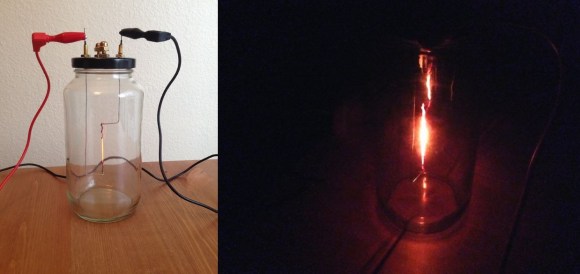
Do you ever look at some of the most classic and world-changing inventions and think, “Darn, I totally could have invented that if I was born 100 years ago!”. Sometimes its a lot of fun to try to recreate these inventions making use of period-accurate materials — like this jar-based carbon filament light bulb!
The project is made out of simple household materials that you probably already have. A jar, some pencil lead, a clothes hanger, some nuts and bolts, a bit of silicone, piano wire and a bit of JB weld. The only thing you might not have is some compressed CO2 — unless you have a kitchen fire extinguisher, a paintball gun, or one of those home-made pop carbonation machines… Alternatively you can just buy some dry ice and let it sublimate in the bottle before you seal the bulb.
No fancy tools are needed (except for an air nozzle for filling the bulb), and it’s not too difficult to construct. The trickiest part is probably drilling small holes through the screw, but if you choose nice brass screws it’ll be quite easy to do.
Once it’s all assembled, plug it into a car battery and enjoy your inefficient 1-lumen light bulb! Still — pretty fun experiment!















Now power it with a kart of baghdad batteries , like the ancient aliens guys think the egyptians did. It actually makes sense that the priest’s held tech , like batteries and bulbs for lighting work inside pyramids.
They had to, otherwise how would they light the moon landing set’s while filming?
My father told me he tried something of the sort when he was around four. With a milk bottle. And just plain wire, without a lead. My grandfather came home to find him crying on the floor because the fuses had blown and there was no power XD
Same here.
Brilliant! I found a chunk of iron ore a week or so ago…CHALLENGE ACCEPTED :) I am going to see how far I can get without any modern tech (or the internet). I know how to make fire, rope etc but toasters and electronics, well, we’ll see :P
well then smelt that iron ore into iron, then turn it into steel. You don’t need coal, chop down some trees and burn half the trees to turn the other half into charcoal, now you have what you need to make a fire hot enough to smelt iron and fuel your forge.
You only need two blocks of wood planks per three blocks of wood…
There was a version on a TV show where instead of using CO2, they just put a candle in the jar then closed the lid. With the lid preventing any new air coming in, the candle burnt most of the oxygen which gave the filament a fairly decent life-not as good as this one though!
I’ve seen a very similar demonstration on Tim Hunkin’s Secret Life of Machines series. He made a light-bulb out of a pencil lead (graphite), IIRC.
There is an easy way to generate CO2 at home.
baking soda and vinegar :
NaHCO3(s) + CH3COOH(l) → CO2(g) + H2O(l) + Na+(aq) + CH3COO-(aq)
I would have expected something more along the lines of a home-built aspirator (water-driven) to pull the air from the jar, then back fill slightly with Argon / CO2.
It brings me back to my old days … will have to do this again ;)
Re: “period materials” — it’s a little-known Fact that Nikola Tesla invented JB Weld, but one of Thomas “Dirty” Edison’s shell corporations bought up the patents to keep it from seeing the light of day until the 1960s.
Where can you find a leaded pencil though?
What you actually want is a pencil “lead” made of graphite, which all pencils have.
“…recreate these inventions making use of period-accurate materials…”
such as silicone and JB weld?
Ok, it’s still cool but I couldn’t resist!
I thought baking soda and vinegar made CO2?
happy birthday tesla heres a lightbulb…
Ok, now I’m sure everyone here is a smart cookie.. but don’t completely close the lid on your jar if you are letting dry ice sublimate in it. >_< You know what dry ice bombs are.. be careful. :P
You could probably put some kind of relief valve into the cap that way excess CO2 pressure could escape, then heat he bottle to expand the gas in the bottle a bit and when it cools the pressure would be lower in the bottle than outside and effectively seal the bottle and valve. Also when the zombie apocalypse comes and we have to make our own light bulbs I think we would cannibalize toasters and use the nichrome wire for light bulb filaments, but we’d have to make our toast over a fire like animals, truly a dystopian future.
Real light bulb filaments are made of tungsten.
I think just putting a small weight on top of a flat bit of wood, would do for a cap and for the “valve”. Or maybe rubber bands instead of a weight.
Considering you need a vent hole for the air to leave through there should be no risk of that.
I wonder how long before congress bans these experiments as well………. lol
Demonstrate your activism by rolling coal!
I wonder if you need to go to all the trouble of getting CO2. Modern pencil leads are made of graphite + polymer. If you pass a small current first, the polymer will melt out of the graphite and burn, using up all the oxygen in the bottle. You can then go ahead with the full current.
Red hot carbon will react with carbon dioxide to form carbon monoxide. Run the jar for a few hours and the contents could be lethal.
Yeah to bugs that you drop into the jar.